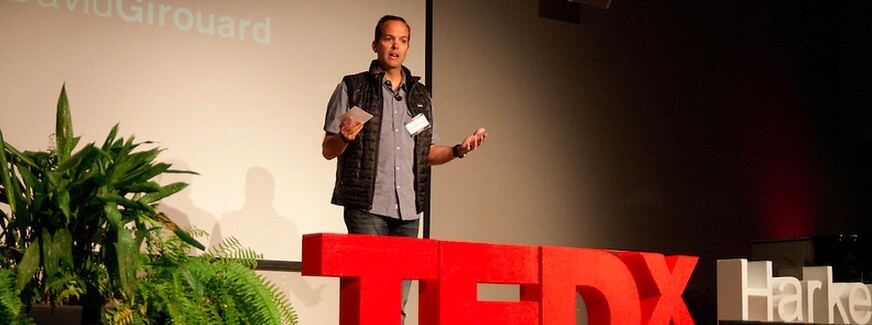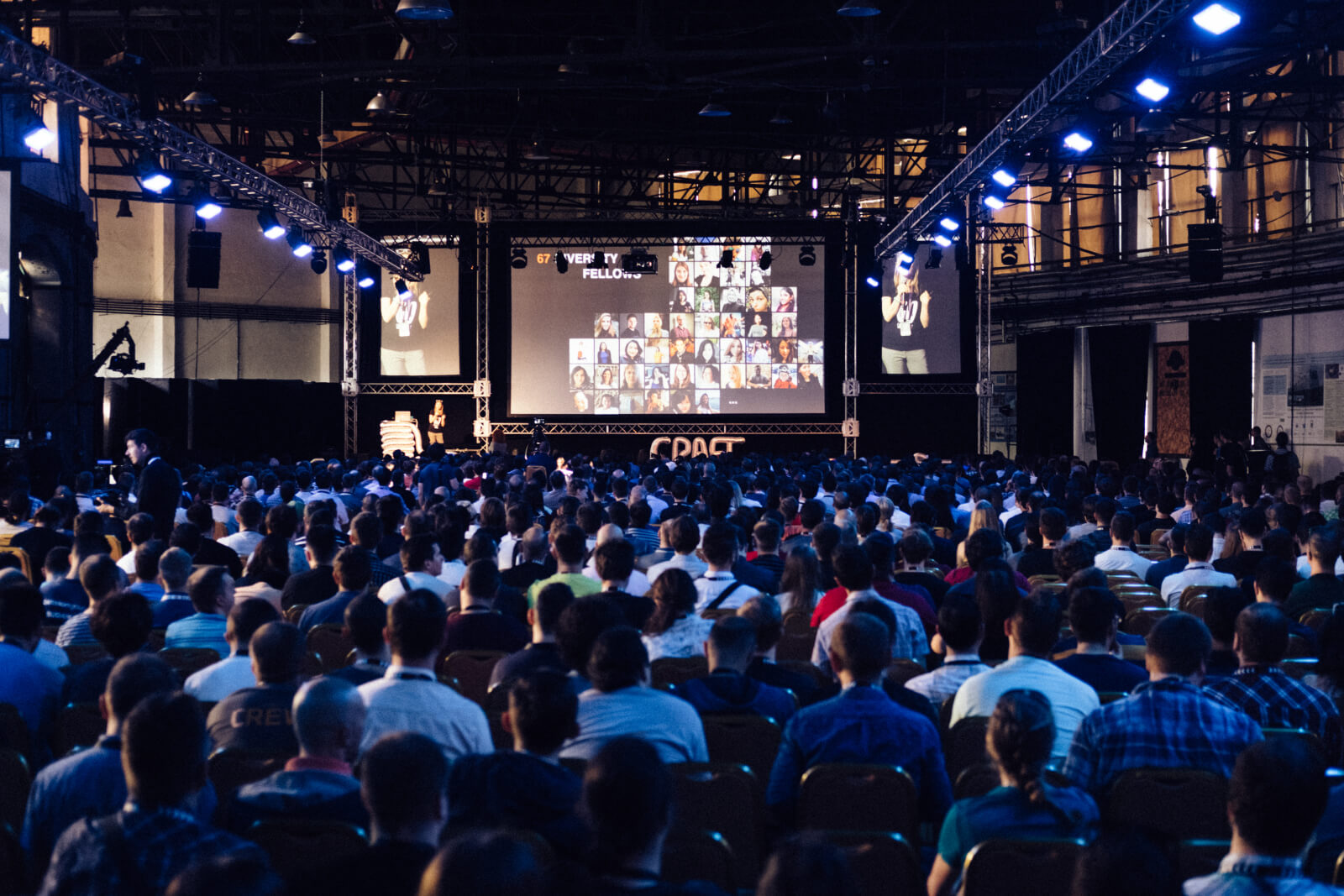Recently I’ve attended a renowned conference dedicated to event professionals. Naturally, my expectations were high as I expected event organizers to play their best cards and show off in front of their peers. And they did. But only partly. While the venue, accommodation and outing activities were world-class, the content side of the conference fell behind.
It made me think once again. Why do event planners put so much effort into catering to attendees’ physical needs but neglect audience’s learning?
The answer would be too long for this blog post. But I have a few interaction tips that you can easily implement at your next conference and increase knowledge building of your delegates.
1. Hire a professional moderator

Hire a professional moderator, if you really want to make your event stand out. A few people realize that event moderators and chairmen have a major impact on the engagement level at conferences. Their role expands far beyond just introducing speakers onstage.
A good event moderator is an audience champion that:
- listens to delegates
- incorporate their input
- collects their questions
- facilitate discussion with speakers on their behalf
- and much more
He/she is not afraid to use new tools and backchannels to draw participants in and make them an active part of a conference. At EMEC 2015, conference MC Dave Sharpe followed the feed of event tweets and read out the best ones during intermezzos. He cracked everyone up with funny quotes and remarks, putting conference attendees into the spotlight!
Mauricio E Candiani, the MC of World Meetings Forum, masterfully used an entertaining live poll to find out if attendees knew one another. After displaying the poll results, he got attendees to meet their neighbors whom they hadn’t known yet, wittily endorsing onsite networking.
But if you want to make your moderators increase audience engagement, you need to give them some space where they can do it. And there’s no better time for that than Q&A time.
2. Leave space for Q&A

This is the easiest yet the most effective way to insert some interaction into your conference without changing your working conference model. Simply allocate some time for Q&A.
Because there is nothing more disengaging than making your attendees listen to lengthy one-way presentations with no engaging activities.
We like giving the following example. You and I are having one-to-one meeting and I would talk for 30 minutes and you would only have to listen. Would you want to attend such meeting? I assume that you wouldn’t. So now multiply this scenario hundredfold and you get a picture of a modern-day conference.
Including your audience in discussions is not rocket science! Instead of having your presenters speak for the full hour, try to split their slot in the following ratio:
40min talk: 20min Q&A or even 30min talk: 30min Q&A
To dig more into how to organize a successful Q&A session take a look here.
3. Leverage technology to crowd-source questions

It all sounds great but … – no questions, no Q&A! And every event organizers dreads that silence in the room when the moderator prompts the audience: “Do you have any questions?”
Luckily, there are tools that can help you collect questions for your Q&A sessions.
In recent years, the events industry experienced the rise of Q&A tools that allow event planners to crowd-source questions from the audience. Attendees can submit their questions via their smartphones and democratically vote up the ones they find most relevant for discussion.
The advantage of these tools is that you can gather the questions already during the talk. So when the Q&A time comes, you have a stack of prioritized questions ready for turning presentations seamlessly into conversations.
When you decide to use a Q&A tool, have the following points in mind to get it successfully adopted.
- Introduce it at the offset of an event
- Prompt attendees before each session to submit their questions
- Encourage a moderator to ask submitted questions to speakers
4. Prepare your speakers

Until now, I’ve been talking about interaction but I omitted the most important element – speakers. Your speakers are the backbone of your event. And if you want to make your conference engaging, you need to make sure that their talks are captivating! And that can be hardly done without briefing or preparing them.
TED speakers usually undergo a spartan training but then that’s why their talks are so compelling! And TED advises their enthusiastic TEDx organizers to follow its guidelines and accompany their speakers on every step they take along the way to stage.
If these rules look too rigid, take a look at these simple tips you can give to your speakers for making their talk more gripping.
In any case, a captivating talk is a stepping stone to great engagement at your event. And that can rarely be achieved without briefing and preparation of your speakers.
5. Offer interactive alternatives

People don’t want to listen only to a string of talks. They like diversity. Offer your delegates sessions that are built around interactivity for a change. Get inspired by the following interactive session examples from conferences that get interaction right:
Interactive campfire sessions at EMEC 2015
At these sessions, attendees can learn from one another through sharing their own experiences. These 30-minute sessions are set in a laid back environment, simulating the campfire storytelling time. The facilitator introduces a topic and then he/she facilitates a discussion trying to reveal common issues and solutions.
Discussion tables session at FRESH 2014
Divide your audience into groups of 5-8 and seat them at tables. Give each group a different topic to discuss. Let them share their knowledge and experience with one another for about 10 minutes. When the time’s up, make them choose another table with a new topic and new participants. By default, these session formats carry a strong human element, which naturally endorses after-session networking.
Case studies session at Marketing Festival
People love seeing successful and actionable examples, alongside motivational talks. Organize a 40-60 minute session where different speakers are each given 5 minutes to present their case study, one after another. No long introduction or biographies, just straight to the point.
6. Re-energise audience with edutainment
Conferences are usually long and no matter how captivating and stimulating speakers are, people get tired towards the end. Try to re-energize your audience with edutainment. The term edutainment comes from two words – education and entertainment. It’s now just a plain clown show, it usually delivers an important message in sarcastic yet entertaining fashion.
Booking an edutaining comedian can help you re-spark the energy in the room and close the conference in a joyful and energized atmosphere.
And that’s important because you want your attendees to leave your conference ecstatic, looking forward to your next year’s edition.
In conclusion
I’ve presented 6 ways to make your conference more engaging. By implementing these tips, you can endorse learning of your delegates, create an immersive experience and pull off an event that your attendees will love.
So let’s wrap it up.
- Hire a professional moderator
- Leave space for Q&A
- Leverage technology to crowd-source questions
- Prepare your speakers
- Offer interactive alternatives
- Re-energize audience with edutainment





